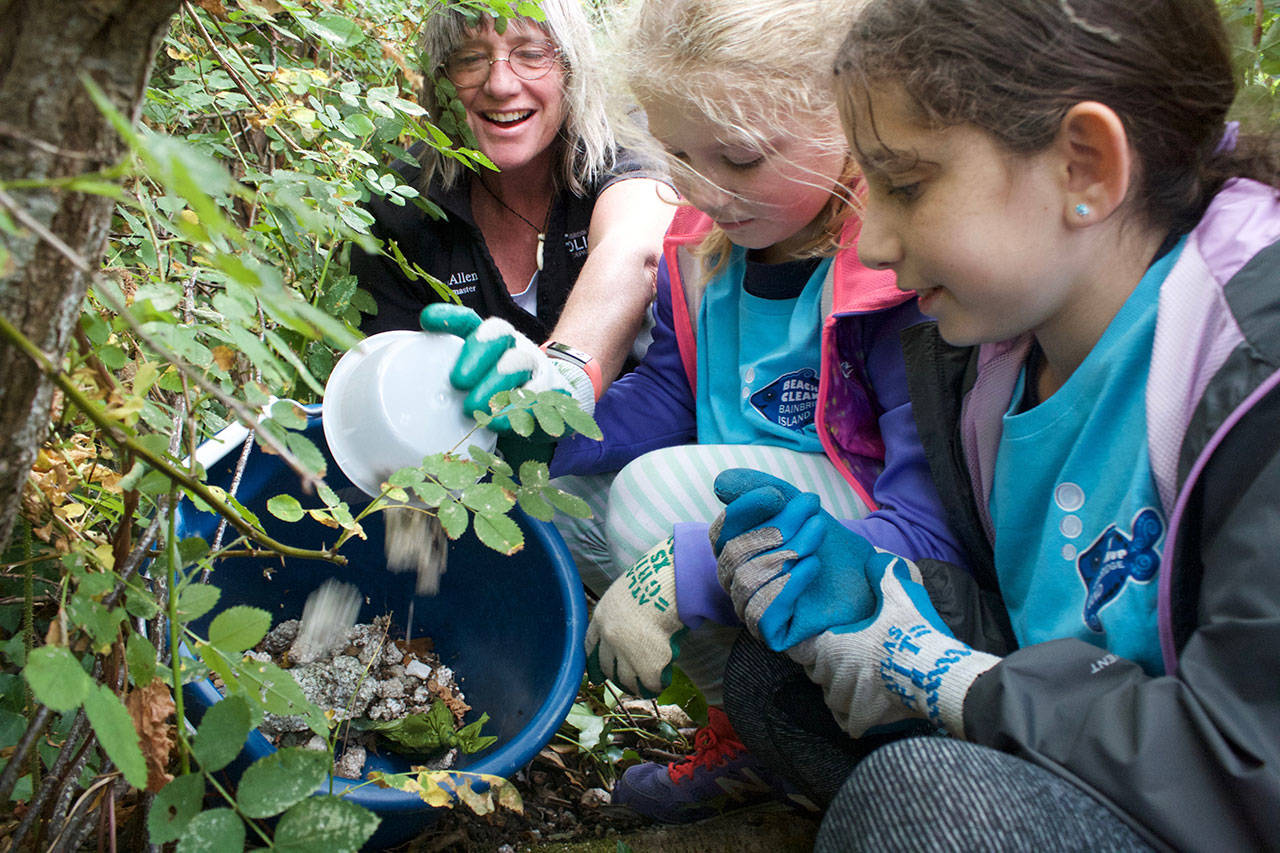What a load of garbage. But isn’t it great?
Bainbridge’s beach cleanup has once again succeeded in bringing volunteers together in order to gather trash from the shoreline.
Our planet’s shorelines are particularly susceptible to pollution, what with the massive amounts of garbage and other pollutants that find their way into our oceans and waterways. Often, beaches end up acting as a sort of filter for the flotsam and jetsam pushed to shore by winds and tide.
Recently, islanders took it upon themselves to do their part to make sure that Bainbridge beaches stay trash-free at the Bainbridge Beach Cleanup, the annual mass-cleaning of Bainbridge’s 53 miles of shoreline. The event, organized by Sustainable Bainbridge, found multiple groups joining forces in rolling up their sleeves and tackling pollution one Hefty bag at a time.
On a gray and windy Saturday afternoon, Stephanie Appleberry was leading a band of volunteers in cleaning up the island’s southern shoreline at Fort Ward. Appleberry serves on the board of directors for the nonprofit Friends of Fort Ward, and said it was the group’s second year participating in the beach cleanup.
“This is our neighborhood beach. This is the one we go to all the time, so it’s really important for us to keep this beach clean,” she said.
”Bainbridge Island does an amazing job every year on this, keeping the beaches clean,” Appleberry added.
Along the bank beside Appleberry was a large fiberglass piece of what appeared to be the transom of a boat which had apparently washed ashore. Neither the origins of the boat nor the fate of her crew was apparent, but such a find wasn’t exactly out of the ordinary.
“Last year we were pulling out remnants of an old building down here in Fort Ward, we were pulling out pieces of iron. We weren’t really sure what they were, we were just pulling them out of the cliff,” Appleberry said. “We took them to the Bainbridge Island Historical Museum. I’m not really sure what they did with them, but they document that kind of stuff.”
While she never found out if she had stumbled upon anything of historical significance, Appleberry said she was excited to see what she might find next.
“It was interesting to know that there was a building there at one point, that isn’t there anymore, of course. It’s like a treasure hunt down here sometimes, when you’re just doing a beach cleanup and — boom — you just run into remnants of a building. That’s cool.”
On the eastern side of the island another group of volunteers was pawing at the sand, trying to loose tiny bits of plastic foam, called “nurdles,” from the sand.
Among them was Deb Rudnick, a board member for the Bainbridge Island Land Trust, and Tami Allen, Eagle Harbor’s harbormaster. Also in the bunch were youngsters Hannah Rudnick and Elle Perkins.
An ecologist, Rudnick has an extensive career in stream, wetland and estuarine ecology and she demonstrated some of the tricks of the trade. Rudnick filled a bucket up with sticks, sand and invariably, the tiny plastic foam nurdles that have become infused with the shore at Hawley Cove.
Then, using a large sieve which looked better suited to draining pasta, Rudnick began filtering out the sand to leave behind the sticks and plastic foam bits.
The team was working beside a small opening in the dense underbrush, which looked as if it would present a laborious task for even a raccoon to pass through.
Allen worked her way into the hole, feet first. Once inside, she coaxed Hannah and Elle to follow, assuring the pair that there would be enough room for the three. The team was clearly on a hunt.
“Yup, this is it. We’re in the right spot,” Allen called back to the girls, her voice slightly muffled through the wall of undergrowth.
Allen reached an arm back out the hole and in her palm were several moderately-sized chunks of plastic foam. She was first tipped off to the existence of a large deposit of plastic foam by the late Jack Welfare, a longtime island resident and avid diver who spent much of his life in or near the waters around Bainbridge.
Handful after handful of plastic foam was pulled up from the dirt. Allen worked beside Hannah and Elle, who both bravely decided to follow her into the thicket’s maw after some initial apprehension.
Later, Rudnick walked toward the water with her bucket of natural and unnatural debris. Rudnick filled the bucket with water in hopes that the plastic foam would float to the top.
“That’s not bad, actually,” Rudnick said pouring the water back through the sieve again, watching as the nurdles clung to the sieve. Repeating this process, Rudnick was left with a reasonable amount of separation between the plastic foam and natural debris.
“That’s pretty amazing,” she said.
Rudnick made her way back to the beach to dispose of the leftovers in a garbage bag.
Just one bucket down, and a whole shore to go.
Multiplying the amount of work involved just to filter one bucket of debris by the number of beaches around the world might cause one to become disheartened. But looking further down the beach on a Saturday afternoon at the groups of volunteers, parents and kids all carrying buckets and trash bags — actively working to keep the shores of Bainbridge trash-free — the task actually starts to seem manageable.



